W163, oder "Oh Gott, wie konnte er nur? Und das nach vier G-Modellen ..."
Ja, das war der "Neue": ML55, smaragdschwarz, 10/2000, aus erster Hand, 85.000km, DC-Scheckheft (09/2008-06/2009)
Wichtige technische Daten: Leistung 347 PS, Drehmoment 510 Nm (2.800 - 4.500 U/min), vmax 235 km/h, 0-100 km/h 6,8 s, permanenter Allrad-Antrieb, Einzelradaufhängung, keine Sperren, dafür ABS, ASR, ESP, BAS, 4 ETS (wie die neueren G-Modelle ab CAN-Modell-Pflege 2001/2002), Leergewicht: 2,23 to, zGG = 2,75 to, max. Anhängelast (gebremst) = 3,365 to --> ZGG = 6,115 to. Die langen G der Baureihe 463 kommen auf ein ZGG von 6,55 to (zGG = zulässiges Gesamtgewicht, ZGG = Zuggesamtgewicht).
 |
Erste
Erfahrungen mit dem ML55 im Vergleich mit den vier G vorher: Deutlich lumpigere Verarbeitung (mein ML wurde in Tuscaloosa gefertigt, und nicht in Graz) als beim G, viel Geklapper, was sich aber (teilweise) abstellen lässt, für ML-Verhältnisse relativ wenig Rost / Flugrost am Chassis, Karosserie rostfrei - ich habe schon schlechtere ML gesehen, die deutlich jünger waren ... Weniger LKW-/Geländewagen-Feeling, man fährt den ML eher wie einen PKW. Im Vergleich zum G genial kleiner Wendekreis, der im Alltag viel bringt. Spürbar günstigere Verbrauchswerte (circa 3 Liter/100km durch besseren cw-Wert) als beim vergleichbaren G, insbesondere bei flotter Autobahnfahrt: Durchschnittsverbrauch; 17,05 l/100km |
|
Resumée: Ich hatte Schlimmstes
befürchtet, was sich jedoch Der ML macht bisher richtig Spaß, vermutlich aber aufgrund des perfekten Preis-/Leistungs-Verhältnisses (SUV und Geländewagen sind alle böse, fast keiner will sie mehr haben, und deshalb sind sie schön billig). Bei VW bekommt man zu diesem Preis momentan keinen "nackten" Golf. Und warum kauft man einen ML55, und nicht den |
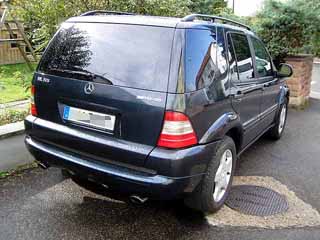 |
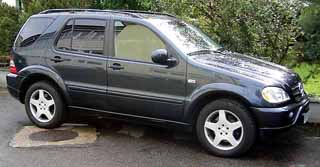 |
Einfache Antwort: Weil ein vergleichbar ausgestatteter ML270 CDI mindestens dasselbe kostet, weniger als die halbe Leistung bietet, und man mit jedem km, dem man sich der 100.000 km-Marke nähert, Angst haben muss, dass der eine oder andere Injektor, der Turbolader, die Hochdruckpumpe, etc. kaputt geht. Aus meiner (zwischenzeitlichen) Sicht absoluter Schwachsinn, sowohl ökonomisch als auch ökologisch (Auch Injektoren und Turbolader und Pumpen werden nicht aus Holz geschnitzt, sondern müssen gebaut werden -> Nachhaltigkeit (!) |
| Der
günstigere Verbrauch eines CDI wird den Gesamt-Aufwand (Ersatzteile,
Öle, Abfall), der für diverse Reparaturen bei einem CDI nötig werden
wird, bei meinen geringen km-Leistungen niemals ausgleichen können!
Und über Zuverlässigkeit sprechen wir am besten gar nicht ... Zum "Welt retten" führt der Fuhrpark noch einen smart CDI, welcher zu Zeit ohnehin mit Abstand am meisten bewegt wird. Wie sich der ML im Vergleich zum G im Gelände fährt, werde ich hier demnächst berichten, sobald geeignete Reifen zur Verfügung stehen. |
 (C) DaimlerChrysler 1999 (aus Prospekt) |
 |
Nach Tausch des OT-Sensors, aller 16 Zündkerzen, des Luftmassenmessers sowie zweimaliger Reinigung der Einspritzanlage in 10/2008 läuft der ML55 nun spürbar besser als bei der Probefahrt und hat sich das Kürzel AMG auf der Heckklappe wieder verdient. Perfekt! |
| 11/2008:
Nerviges Geklapper im Laderaum lokalisiert: Es handelt sich um eine
ursprünglich quer verklebte Traverse aus Kunststoff, die den
Dachhimmel ungefähr auf Höhe der hinteren, mittigen Innenbeleuchtung
stabilisieren soll. Der Klebstoff klebt nach 8 Jahren nicht mehr, und
die Traverse schlägt bei jeder Bodenwelle an das Dach. Nach Ausbau der Lampe, Abbau der Kleiderhaken sowie Entfernen der hinteren mittleren und hinteren seitlichen Abdeckungen konnte der Dachhimmel soweit abgelassen werden, dass ein Lappen zwischen Dach und Traverse geklemmt werden konnte. Seit dem ist Ruhe. Zeitaufwand circa 1,5 h. |
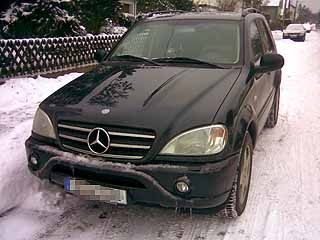 |
 |
12/2008: Nerviges Gehake beim Gasgeben (von Anfang
an). Ursache ist bzw. war das Spielzeug-Gaspedal aus
Billig-Kunststoff, welches inklusive Gaszug (bis zum
E-Gas-Steuergerät) für circa EUR 45.- Materialwert gegen ein besseres
(auch Hart-Kunststoff) getauscht wurde. Jetzt kann man wieder linear
Gas geben, und nicht mehr in 2-3mm-Schritten. Beim 270er ist das evtl.
weniger wichtig, beim 55er sorgen 2-3mm schon für ganz ordentlich
Vortrieb :-) Verkauf in 06/2009 an einen guten Bekannten, weil wieder ein G in Aussicht ist. Alles in allem ein nettes, zuverlässiges Fahrzeug; momentan wegen Wirtschaftskrise und der gentechnischen bedingten Grundangst der Deutschen preislich völlig unterbewertet am Markt. |
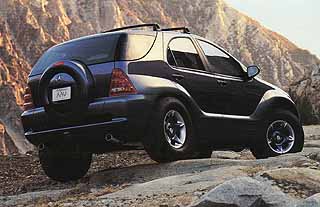 (C) Mercedes-Benz USA 1995 |
Mit der Vorstellung der Studie AAV ("All Activity Vehicle") fing 1995 alles an. Aus dem AAV wurde dann später SUV ("Sports Utility Vehicle"). Nachdem der Mark auf den zweiten Begriff setzte, beugte sich auch Mercedes-Benz und verwendete diesen Begriff ab sofort, und strich AAV aus dem Wörterbuch. |
| Geschicktes Product Placement von DaimlerChrysler in Jurassic Park 2 (Lost World): Die Vorstellung der neuen Baureihe W163 vor einem breiten Publikum in den wichtigen Märkten USA und Europa. |
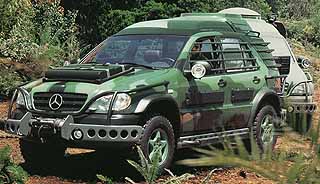 (C) DaimlerChrysler 1998 |
Links zum Thema ML 55 AMG:
AMG Owners Club
http://www.amg-owners-club.de/198.0.html
"Vergleichstest BMW X5 4.6is, Mercedes ML 55 AMG und Porsche Cayenne
S" (ams, 03/2003)
http://www.auto-motor-und-sport.de/vergleichstest/vergleichstest-bmw-x5-4-6is-mercedes-ml-55-amg-und-porsche-cayenne-s-753437.html
"Das 5,5-Liter-Auto" (Autobild, 02/2002)
http://www.autobild.de/artikel/mercedes-ml-55-amg_34066.html
High-Performance ML55 AMG Sport-Utility Now on
Sale / World's Fastest SUV Puts The 'Sport' Into 'Sport-Utility'
(DC USA-Pressetext zur Markteinführung in den USA)
"MONTVALE, N.J., Dec. 29, 1999 -- Mercedes-Benz USA announces that the new
high-performance ML55 AMG is now on sale for $64,900. This
highly-anticipated Mercedes-Benz super sport-utility puts the sport in
sport-utility vehicle. Never before has an SUV been so fast, so luxurious,
or handled so well.
Available in limited numbers in early 2000, this latest M-Class model has
been engineered in conjunction with AMG, Mercedes' long-time
high-performance and racing arm.
The ML55 AMG is the latest variant of the highly successful ML320 and ML430
models. It satisfies a very specific automotive consumer: one who
appreciates the high performance capabilities of a sports car, the luxury of
a fine sedan, and the utility of an off-road recreational vehicle. With a
specially-crafted aluminum V8 engine pumping out 342 horsepower and 376
lbs.-ft of torque, the ML55 AMG has a top speed over 140 mph and can travel
from 0 to 60 mph in 6.4 seconds, making it the world's fastest sport-utility.
Performance statistics such as these are usually reserved for only the
highest-performance sports cars. Additionally, the ML55 AMG's
four-wheel-drive capabilities and ample ground clearance give it the agility
to traverse a snowy highway or gravel country road.
Bambi Meets Godzilla, Courtesy of AMG
Mercedes-Benz recently purchased a majority interest in AMG, the German firm
that has for over 30 years specialized in turning standard Mercedes-Benz
models into high-performance coupes, sedans and station wagons. Now, as a
partner, Mercedes and AMG turn out specialized cars with all the quality,
attention to detail and performance under one umbrella. AMG's motor racing
arm has also won numerous international championships, like the 1997 and
1998 FIA GT crown with the Mercedes-Benz CLK-GTR.
Engines, drivelines and suspension components specific to the ML55 AMG
arrive at the M-Class production facility in Tuscaloosa, Alabama, directly
from AMG's headquarters in Affalterbach, Germany. The ML55 AMG can be easily
identified by its muscular physique. Hefty five-spoke, 18-inch wheels and
low-profile 285/50 R18 tires are covered by sleek fender flares. Clearly
visible through the wheels, red brake calipers (for most body colors) not
only provide a fitting accent but also identify the ML55 brakes -- special
13.6-inch vented discs in front and 13.0-inch discs at the rear.
Unique rocker panels add to the athletic look. Integrated fog lights are
built into the front air dam and a special panel continues the bumper line
across the liftgate. "Power domes" on the front hood hark back to the
legendary Mercedes 300SL Gullwing and roadster of the 1950s, and twin chrome
exhaust tips also hint at the power underhood.
Hauling The Bacon With 342 Horses
The heart of the ML55 is a potent 5.5-liter V8 engine, pumping out 342
horsepower. This engine is unique right down to the block. It uses an
aluminum V8 block cast by AMG, yet retains some of the Mercedes-Benz V8
internal dimensions such as cylinder bore spacing and location of the main
bearings. The large displacement is the result of a special forged-steel
crankshaft with 8mm longer throws for each piston and connecting rod, which
brings overall displacement from the Mercedes-built V8 of 4,966 cc to 5,439
cc. As well, the AMG engine's cylinder bores are 7.1 mm larger in diameter
than the standard Mercedes-Benz-cast V8. The crankshaft is dynamically
balanced, and pistons and connecting rods are selected for each engine in
equal weight-matched sets. The result is a smooth, low vibration powerplant
that produces a massive 376 lbs.-ft. of torque.
To feed the larger displacement, AMG modifies the original magnesium intake
manifold with a wider cross-section to increase airflow. As in the standard
Mercedes manifold, the AMG version features long intake passages that spiral
around to each cylinder. Flaps inside the manifold stay closed below about
3,700 rpm, forcing intake air to take a long route, building up pressure
waves which boost flow and improve low- and mid-range torque. The flaps open
above 3,700 rpm, allowing intake air to take a shorter, more direct route to
the cylinders for maximum high-rpm power.
The ML55 engine uses a special electronic control unit to manage the larger
V8, and fuel injectors have been matched to the increased airflow. The ECU
fires the fuel injectors, controls ignition timing and determines precisely
when the manifold flaps open and close.
The AMG engine retains the twin-sparkplug/three-valve, single-overhead cam
design of the standard Mercedes-Benz 5.0-liter V8, but replaces the standard
camshafts with new modular cams and installs higher-tension valve springs.
The hollow construction of the standard camshafts makes them light, yet the
AMG cams are even lighter. Valve sizes are the same as the stock V8, but the
AMG cams provide longer valve duration for increased power.
The Power of a Clydesdale, the Speed of a Cheetah
Harnessing all that horsepower and torque is a full-time four-wheel-drive
system providing 48/52 front/rear torque distribution. One of the most
innovative and versatile in the SUV market, the M-Class 4WD system uses
front, center and rear "open" differentials that require no driver
intervention.
As with all M-Class models, the ML55 AMG stands apart from most other SUVs
because it does not lock its axles in an attempt to maintain traction on
slippery or loose surfaces. Instead, the M-Class employs an advanced
electronic full-time four-wheel traction control system. To maintain
traction, the system senses slip and applies the brakes on the slipping
wheel, which transfers the right amount of torque to those wheels with the
most grip, on virtually any road surface. The M-Class system provides
mobility even when three wheels lose traction. A two-speed electronically
controlled transfer case gives all M-Class models true off-road capability.
Using traction control rather than locking differentials also aids
maneuverability on any surface. In slippery or off-road conditions, the
benefit of the full-time four-wheel-drive system is obvious. Yet even on dry
roads, the system makes its presence known by giving the M-Class models
secure, neutral handling characteristics.
The extraordinary Electronic Stability Program (ESP) helps drivers maintain
directional stability, especially on slippery or gravel-covered roads by
preventing oversteer (rear-end "fishtailing") or understeer (front-end "plowing").
ESP can sense impending loss of control -- at either end of the car -- then
momentarily applies the brake on one wheel to restore stability, something
that even a skilled driver cannot do.
SUV Utility, Passenger Car Comfort and Safety
The interior of the ML55 AMG more closely resembles that of a luxury sedan
than a go-anywhere, do-anything sport-utility vehicle and sets a new
standard, even for M-Class interior features. Thickly bolstered sport seats
are finished in supple leather contrasted by dark burl walnut trim. The
armrests and console storage are leather covered, as is a portion of the
walnut and leather AMG steering wheel. The ML55 instrument cluster features
chrome-ringed gauges with white analog faces, while the center console holds
a large display featuring an integral navigation and audio system which is
set up for easy add-on of a digital StarTAC integrated portable phone and/or
six-disc CD changer. AMG-embroidered floormats complete the picture.
Beneath the elegance lies a cocoon of safety. Mercedes-Benz M-Class
sport-utility vehicles introduced the concept of crash-compatibility to the
SUV segment. Unlike most sport-utility vehicles, the M-Class frame is also
designed so that it will not override a passenger car's body structure in a
collision. Such compatibility can lessen the severity of frontal impacts
between vehicles of different categories. Although the M-Class uses a
body-on-frame design, the dynamics of its crash protection are roughly equal
to the Mercedes-Benz E-Class luxury sedan, which has unibody construction.
In addition to a front crumple zone built into the nose of the vehicle, the
M-Class incorporates a special structure around the windshield pillars. In a
severe collision, this extra crumple zone can actually help dissipate some
of the energy around the sides of the vehicle, providing even more
protection for the occupants of both the M-Class and a colliding vehicle.
All M-Class models are equipped with advanced four-channel, four-wheel
anti-lock brakes, dual front airbags, the BabySmart automatic seat
recognition system, and this year, side impact airbags in all four doors as
well. The front and rear outboard seatbelts are equipped with both emergency
tensioning retractors and belt-force limiters, and this year, the second-row
center seat also has a three-point belt.
A Chassis Designed for Safety and Performance
The chassis forming the foundation of all M-Class vehicles sets new SUV
standards for ML55 performance, comfort and safety. The M-Class has a unit
body mounted to a strong separate frame with closed, twist-resistant
box-profile sections. The two longitudinal and three transverse frame cross
members are welded together for exceptional strength and torsional rigidity.
Suspension subframes and ten rubber body mounts provide isolation from road
shocks and noise.
The M-Class features independent front and rear suspension, unusual in its
segment. Many SUVs have only independent front suspension, while some even
use solid axles front and rear. Four-wheel independent suspension provides
class-leading handling, stability and ride comfort, both on and off road.
The Mercedes M-Class also uses rack-and-pinion power steering, and a tight
37-foot turning circle gives the M-Class exceptional maneuverability on any
road.
Moving Cargo in Luxury
All M-Class models were developed with passenger comfort, cargo room and
versatility in mind. The ML55 AMG, as well as the ML320 and ML430, feature
the largest side doors in their category, along with a low 18-inch step-in
height to make getting in and out of an M-Class much easier than most SUVs.
Its 111-inch wheelbase is among the longest in its segment, while the rear
seat has ample head, leg and shoulder room for three passengers, thanks in
part to a relatively flat floor. For added versatility, all M-Class models
for 2000 come with a new 60/40 split fold-down rear seat, with a center
armrest.
As with all M-Class models, the ML55 AMG comes equipped with a generous
level of standard equipment: air conditioning with dust and pollen
filtration; a high-performance 80-watt Bose audio system; cruise control;
tilt steering column; power windows with express-down in the front; rear
wiper; dual heated power side mirrors; an outside temperature gauge;
Homelink-compatible universal garage door opener; alloy wheels; four-way
head restraints; carpeted floor mats; pre-wiring for CD changer and phone;
roof rails and a retractable cargo cover.
All 2000 Mercedes-Benz models come with a four-year/50,000-mile warranty,
which includes tires, batteries and adjustments for the full coverage period.
Regularly scheduled maintenance during the vehicle's entire warranty period
is also now free of charge. In addition, the 24-hour Mercedes-Benz Roadside
Assistance program covers all Mercedes vehicles, regardless of model year.
This peace of mind can include a free jump-start, a few gallons of fuel or
mounting the spare tire, even for those driving a decades-old Mercedes."